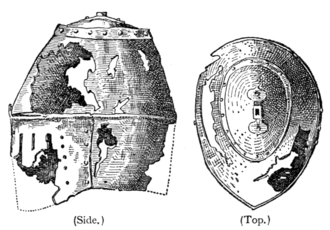The custom of wearing the large helm over the bascinet being clumsy and troublesome, many kinds of visor were invented, so as to dispense with the large helm, except for jousting, two of which are represented in Figs. 575 and 579. In the first a plate shaped somewhat to the nose was attached to the part of the camail which covered the mouth. This plate, and the mail mouth-guard, when not in use, hung downwards towards the breast; but when in use it was drawn up and attached to a staple or locket on the front of the bascinet. This fashion, however, does not appear to have been adopted in England, but was peculiar to Germany, Austria, &c. None of these contrivances seem to have been very satisfactory, but towards the end of the fourteenth century the large and salient beaked visor was invented (Fig. 587). It was fixed to hinges at the sides of the bascinet with pins, and was removable at will. A high collar of steel was next added as a substitute for the camail. This form of helmet remained in use during the first half of the fifteenth century, and the large helm, which was only used for jousting, took a different form, or rather several different forms, which may be divided into three kinds. In this connection it should be remembered that the heavy jousting helmet to which the crest had relation was probably never used in actual warfare. The first was called a bascinet, and was used for combats on foot. It had an almost spherical crown-piece, and came right down to the cuirass, to which it was firmly fixed, and was, like all large helms of the fifteenth century, large enough for the wearer to move his head about freely inside. The helm of Sir Giles Capel (Fig. 588) is a good specimen of this class; it has a visor of great thickness, in which are a great number of holes, thus enabling the wearer to see in every direction. The "barbute," or ovoid bascinet, with a chin-piece riveted to it, was somewhat like this helm, and is often seen on the brasses of


